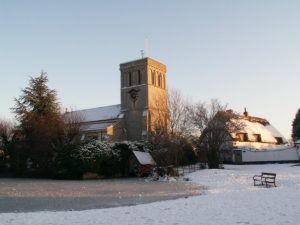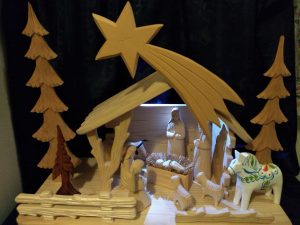| Anglican lectionary: Catholic lectionary: | 1st Reading Isa 52:7-10 both | Psalm 96 – | 2nd Reading Hebr 1:1-4 both | Gospel John 1:1–14 both |
by Revd Margot Hodson, Director of Theology and Education for the John Ray Initiative, UK
SECTION ONE: NOTES ON THE READINGS
Isaiah 52:7-10
 Isaiah is full of images of creation: mountains and deserts, rivers and pasture, animals, trees and flowers. All these speak of an intense sense of the value of the nature. Salvation brings harmony between God, humans and the natural world. Mountains are portrayed as a special dwelling place for God and a place where we can go to come into his presence. Here the messenger of the Lord comes from the mountains with his Good news of peace, salvation and goodwill. All this comes when the Lord returns to Zion to reign over all the earth. Isaiah was written for people who had experienced destruction of their homes and lives through invasion and exile. As we look back on 2021 the invasion of the pandemic has brought us both exile and the ruin of so many hopes and lives. Its environmental origins have laid bare the true scale of ecological crisis that we face. We may feel we cannot rejoice at such times and yet this passage proclaims hope – A saviour is coming and one day ‘all the ends of the earth will see the salvation of our God’. Let us work towards that day.
Isaiah is full of images of creation: mountains and deserts, rivers and pasture, animals, trees and flowers. All these speak of an intense sense of the value of the nature. Salvation brings harmony between God, humans and the natural world. Mountains are portrayed as a special dwelling place for God and a place where we can go to come into his presence. Here the messenger of the Lord comes from the mountains with his Good news of peace, salvation and goodwill. All this comes when the Lord returns to Zion to reign over all the earth. Isaiah was written for people who had experienced destruction of their homes and lives through invasion and exile. As we look back on 2021 the invasion of the pandemic has brought us both exile and the ruin of so many hopes and lives. Its environmental origins have laid bare the true scale of ecological crisis that we face. We may feel we cannot rejoice at such times and yet this passage proclaims hope – A saviour is coming and one day ‘all the ends of the earth will see the salvation of our God’. Let us work towards that day.
Psalm 96
We know from the Psalms that all creation praises God (Psalm 148). Here creation is asked to sing a new song. The early Church chose to celebrate the birth of Christ in the depths of winter. It points us forward to the new birth in the spring, when creation will sing a new song once again. Even in the southern hemisphere, we can look for that new life in every new shoot that comes and creature that is born. It is God who made the heavens and all the earth rightly trembles before him, in awe of his greatness. Through Advent we have focussed on the coming of Lord to judge the world and bring in his just rule and reign. On this day when we remember his coming as flesh for our salvation, we can pray for his coming again and for a restoration of his creation. We can rejoice in that hope with all the Earth.
Hebrews 1:1-4
The enigmatic author of the Letter to the Hebrews wrote in beautiful Greek. He began his letter by reflecting on the relationship between God, humans, creation and redemption. This is a cosmic passage where the lens is pulled out and we can see Jesus as the one through whom the whole universe was made. The writer explained Jesus as ‘the radiance of God’s glory’ and ‘heir of all things’. This passage resonates with Paul’s reflection in Colossians 1:15-20, where he considers these relationships in the context of the Cosmos and redemption. By beginning with this vast, cosmic picture, the writer is then able to focus in on the Temple sacrifices and show how the work of atonement is now complete through the work of Christ.
Christ has sat down at the right hand of God and continues to sustain all things through his word.
As the Body of Christ on Earth, Christians have a calling to live so that we sustain creation and give the glory to God.
John 1:1–14
At Christmas we remember the amazing truth that Jesus, the light of the world, was born among us. In John 1 we see how the doctrines of creation, incarnation and salvation interact. Jesus is revealed in three unique ways: existing before the world began, being divine, and being the agent of creation. The passage reaches a climax in verse 14: ‘the Word became flesh and made his dwelling among us’. The environmental implication of this statement is profound. When our holy and perfect Creator became flesh, he affirmed the continuing goodness of his creation. In creating the universe, God brought light to the whole world. The darkness described in verse 5 is not part of God’s good creation but is the very absence of that goodness that has blinded human eyes, preventing people from recognising the light of Christ and actions that have caused damage and destruction. When humanity embraces the light, it should also regain the Creator’s love and care for his world. Humans can find full adoption as children of God through believing in Christ (vv. 12–13) but light is given to all. When God makes his dwelling among us, his glory shines through all creation.
Please see note below for this reflection.
SECTION TWO: DRAFT SERMON/SERMON OUTLINE
How to preach an environmental sermon at Christmas?
This can seem a bit of a challenge – surely we should be focussing on the birth of Christ? The exciting truth of a Christmas environmental sermon is that the incarnation is completely and utterly environmental: Jesus, a member of the God head, through whom the world came into being, was made flesh, became a creature for the sake of his creation.
John 1 is a classic Christmas passage and the points outlined in the notes above bring out the core message of an affirmation of our material world, the interaction of creation, incarnation and salvation.
Isaiah provides a picture of the ultimate harmony between God and the whole of his creation.
Psalm 96 picks up on that theme and proclaims that all creation rejoices at the coming of the Lord.
Finally Hebrews 1 echoes John 1 with a beautiful description of the cosmic Christ who sustains all things through his powerful word.
In are preaching this year, we are bound to look back on the difficulties of 2021 with the pandemic, the many environmental disasters, and the challenges and heart-breaking injustices that have been laid bare as Covid-19 has travelled around our world. It is important to understand that the pandemic is not natural evil but comes from our abuse of the natural world in ways that have brought wild animals into close contact with humans. Some people have had more free time to reflect, others have been much busier, but most people have been more rooted in our own homes and communities. This has enabled many to more fully grasp how we have been misusing our world and one another.
We can then look forward to 2021 and how we can truly be bringers of God News both to people who are experiencing poverty and injustice and to ‘all the Earth’ that deserves our urgent care and restoration.
We can give that challenge to be bringers of light and heralds of just restoration. What are we going to do in 2021 to bring light to nature, suffering from human oppression and for people suffering from oppression and poverty? Can we commit to one intentional action a month? Or even one a week, to rebuild our broken world to be a better place for people and the creatures of the Earth? How can we be windows through which ‘the radiance of God’s glory’ can shine?
SECTION THREE: ADDITIONAL MATERIAL
Note on John 1:1-14: This is an edited extract from a reflection will feature in a new book “Green Reflections” by Martin and Margot Hodson to be published by the Bible Reading Fellowship in April 2021: https://www.brfonline.org.uk It was originally written for: Guidelines, Bible study for today’s ministry and mission, Oxford: BRF, 2013, Vol 29 part 1.
Green Grove
Grove Booklets have produced useful material for Christians on a wide number of environmental themes, including a booklet on Isaiah’s Environmental Ethics and one on COVID-19: Environment, Justice and the Future. These booklets have a small cost either as booklets, or a downloadable pdf. The links to those with environmental themes, have been grouped together on the John Ray Initiative and can be found here:
https://www.jri.org.uk/resources/green-grove
Thoughts in Sustainable Preaching
These passages say amazing things about God’s creation and the interaction between God, humans and the rest of the natural world. The challenge is how to bring that out without losing folk who are looking for something with a focus on God and humans alone. My own approach for a Christmas sermon (and for many others) is not to focus on environment as the only point of the sermon, but to weave in the environmental themes so that every sermon helps to build a worldview where the intrinsic value of nature is understood and promise of salvation and restoration for the whole of creation. As that worldview becomes established, so Christians and whole congregations start to respond to God’s world in loving and caring for it.
Thoughts on Isaiah 52:7
Back in 2007, I had the great (if terrifying) privilege of leading a Sunday Morning service on a live broadcast for BBC Radio 4. The speaker was Sir John Houghton, the great climate change scientists, a founder of the IPCC and a deeply committed Christian. Our venue was the Chapel of Jesus College, Oxford, where I was chaplain and the occasion was the publication of the IPCC fourth Assessment Report. As the service was about to begin, I mused that I had a world leading professor, a Lord of the realm (our College Principal), about 80, 18-22 year-olds, on whom we were totally dependent as we were about to go live to the nation! Sir John was compelling and inspiring, and the students were superb with wonderful readings and prayers (which generated a huge number of letters from older people heartened by their young voices, so full of faith). This year sadly, Sir John died of COVID-19, but his work lives on both in the scientific community in combatting change and in the movement that he nurtured among Christians to care for God’s creation. The music created by the students that morning was outstanding, and whenever I read Isaiah 52, I can hear their voices as they sang ‘how beautiful on the mountains’ by Sir John Stainer. These words stay with me as I look to 2021 with the hope that there will be Good News and we can rebuild our world to be a fairer and greener community for all creation.
by Revd Margot Hodson, United Kingdom
 Erasmus+ – project
Erasmus+ – project
